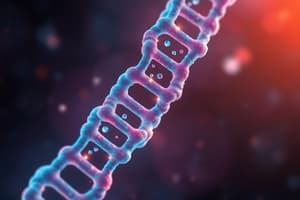Podcast
Questions and Answers
What does nondisjunction of chromosomes mean?
What does nondisjunction of chromosomes mean?
- Duplicating DNA
- Formation of end cells
- Failure of chromosomes to separate (correct)
- Abnormal transverse division of chromosomes
During the G1 stage, the cell performs its specialized functions and does not divide.
During the G1 stage, the cell performs its specialized functions and does not divide.
True (A)
What are the four stages of inter-phase?
What are the four stages of inter-phase?
G0, G1, S, G2
What is formed during the S-stage of the cell cycle?
What is formed during the S-stage of the cell cycle?
What happens during the G2 stage?
What happens during the G2 stage?
The abnormal transverse division of chromosomes is known as ________.
The abnormal transverse division of chromosomes is known as ________.
How many centrioles are present in the cell in G2-Stage?
How many centrioles are present in the cell in G2-Stage?
Study Notes
Nondisjunction
- Nondisjunction is the failure of chromosomes or chromatids to separate properly during cell division.
- This results in one daughter cell having extra chromosomes and the other having fewer.
Isochromosomes
- Isochromosomes form due to abnormal transverse division of the chromosome instead of longitudinal division.
- The resulting chromosomes have four short arms or four long arms.
- The sticky ends of these chromosomes join together to form a ring chromosome.
The Cell Cycle
- The cell cycle consists of the mitotic period (cell division) and interphase (rest and preparation).
- Interphase is further divided into G0, G1, S, and G2 stages.
G0 Stage
- Cells may exit the cell cycle during G0 and re-enter later.
- Cells that stay in G0 permanently are called end cells and do not divide further.
G1 Stage
- The period between the end of mitosis and the beginning of S-stage.
- Each daughter cell has 46 chromatids called interphase chromosomes (S-chromosomes).
S Stage
- The cell duplicates its DNA during this stage.
- Each cell now has 92 S-chromosomes.
G2 Stage
- A short period between S-stage and the beginning of mitosis.
- Identical pairs of chromatids join at the centromere to form d-chromosomes.
- The number of centrioles and the amount of tubulin protein increase.
- By the end of G2, the cell contains 46 pairs of identical chromatids (d-chromosomes) and 4 centrioles.
Studying That Suits You
Use AI to generate personalized quizzes and flashcards to suit your learning preferences.
Related Documents
Description
Explore the crucial concepts of nondisjunction, isochromosomes, and the various stages of the cell cycle, including G0 and G1. This quiz covers important definitions and details that are essential for understanding chromosomal behavior during cell division. Test your knowledge and grasp these fundamental biological principles.




